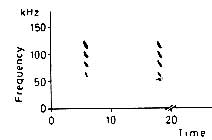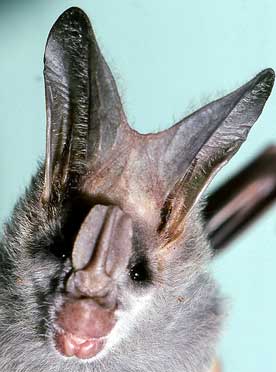Megaderma lyra
Greater False Vampire Bat
Morphological description Life history Distribution Habitat Roost sites and roosting patterns Emergence and flight pattern Foraging behaviour Echolocation calls Status and protection
The image above was taken in southern India.
Morphological Description
· Dorsal fur is mouse-grey. Ventral fur paler. Juveniles are darker.
· The body size is relatively big. Average forearm length 66.4 mm (56.0-71.5mm) (Bates & Harrison, 1997).
· The ears are big, joined medially for a third of their length, and contain a bifid tragus. The noseleaf is erect and 10mm in length (Bates & Harrison 1997).
Life history
· Mates in autumn (November, in South India), and birth occurs in April. It will be delayed by a few days in colder areas (copulation in mid-December, parturition in May, in North India). gestation about 145 days. Young are carried by mother for 20-25 days and suckling occurs for a further 15-20 days. Young weigh 10.3 g at birth, and the mother on average is 36.2 g (from Bates & Harrison, 1997).
· Single young usually born in spring. Twins are occasionally found.
Distribution
Wide ranging: found from Afghanistan to southern China, south toi Pakistan, India, Sri Lanka and Malaysia (Bates & Harrison 1997).
The Chinese distribution is shown by dots on the map below (as given by Zhang et al. 1997).

Habitat
· Humid forest is the typical habitat.
Roost sites and roosting behaviour
· Generally they roost in caves, but are also found in temples, forts, underground tunnels, cow sheds, grain stores, shallow soap stone mines, attics of houses and old buildings (Bates & Harrison, 1997)
· A large colony was discovered at Aurangabad in India, with 2000 individuals and contained breeding females and males (from Bates & Harrison, 1997).
· Occasionally, solitary males may be found in the dense foliage of a large-leafed tree or palm (Bates & Harrison, 1997).
· This species can share their roosts with other bat species.
Emergence and flight pattern
· Emerges late, sometimes an hour after sunset (in Bates & Harrison1979).
Foraging behaviour
· The diet of this species has been well studied and mainly consists of insects and small vertebrates, such as fishes, amphibians (frogs and toads), reptiles (lizards), birds(white-eyes, sunbirds, sparrow, dusky crag martin) and mammals (bats, rats, mice, gerbils). A summary of studies is given in Bates & Harrison (1997).
Echolocation calls
.The echolocation calls are multiharmonic, brief and frequency-modulated. The spectrogram below is taken from Habersetzer (1986). the species can use passive listening to capture prey on the ground (Fiedler 1979), but uses echolocation to capture prey from the water surface (Marimuthu et al. 1995).

Status and protection
· There is no estimation of population size China.
· Greater false vampire bats are at LR/lc, assessed by the Red List of Threatened Species (IUCN, 2006). They are widely distributed in some areas of southern Asia. They are not listed in the Law of the People's Republic of China on the Protection of Wildlife in 1989.
· Caves, forests and old buildings should be protected as their habitats.
